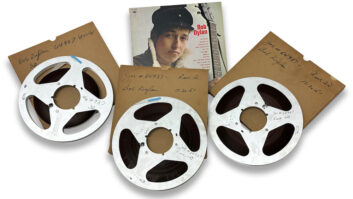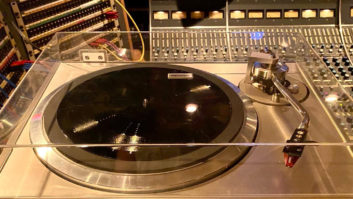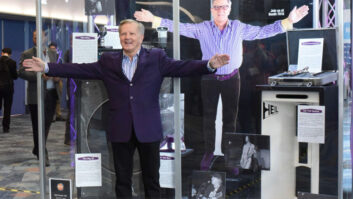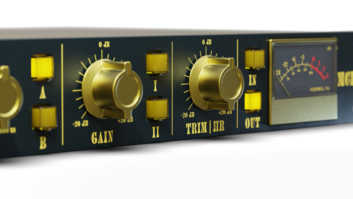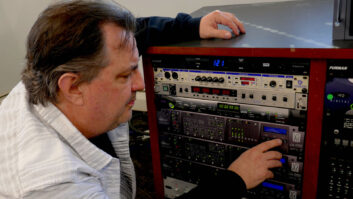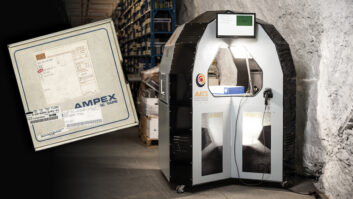
New York, NY (December 22, 2020)—Many are familiar with sticky-shed syndrome, which can cause the magnetized coating on certain recording tapes to separate from the backing due to the deterioration of the binder—the glue—holding them together. Now, one archivist is drawing attention to a new issue that can render some old tapes unplayable.
In “Forever Young: Preserving the Archive of Bob Dylan,” a panel hosted by the Recording Academy, Kelly Pribble, principal studio engineer/preservation specialist, Iron Mountain Entertainment Services (IMES), discussed what he called “Adhesion Syndrome,” which affected the masters for two Dylan albums. “The edges are bound together, and as you unwind the tape, it rips the tape,” said Pribble. The condition can pull the oxide from the backing, creating pinholes.

IMES began working with The Bob Dylan Archive a few years ago, and the projects affected by Adhesion Syndrome were the Empire Burlesque album, released in 1985, and 1986’s Knocked Out Loaded album. The tapes were initially being digitized by another archivist who recognized that they required special treatment. “Kelly was the person to do it,” said Dr. Mark Davidson, archives director of the American Song Archives, also on the presentation panel.
“Broadly, we’ve been working through Dylan’s session tapes chronologically,” said Davidson, who collaborates with a number of vendors for film and audio preservation. “When we started working on these tapes in the last year and a half, we were up to the mid-’80s and it was the first time we had experienced this sort of problem.”
“All together, there were 63 two-inch masters from Bob’s two records that we were able to safely unbind and transfer successfully,” said Pribble. “We were extremely proud to have the opportunity to be a part of Bob Dylan’s legacy, to be able to pull these out, recover them, transfer them and provide the files to the organization.”
The collection’s digitized assets, which span Dylan’s entire career beginning in high school in the mid-1950s, are being made available to researchers via Starchive, a cloud-based digital asset management software.
“I didn’t have to do much once we were unbound and transferred. The audio was pretty good,” said Pribble of the affected master tapes. That was largely due to the way these Dylan sessions were conducted, it seems. Adhesion Syndrome is worst where the pressure is greatest, close to the reel hub, he said. “I learned that they would let tape roll for a minute or two before they recorded anything. That was very helpful with this collection. If it had started right at the beginning of the tape, I probably would have had more problems with it.”
Pribble enjoyed the fly-on-the-wall experience of listening to the sessions, he said. “Bob would just start playing a lick on guitar, everybody would join in and it was a song. That was amazing to listen to. There’s banter back and forth, and starts and stops. I felt like I was in the studio the day they recorded it.”
Discovering—and Preserving—the Earliest Known Stereo Recordings
He captures analog audio assets through Prism Sound ADA-8XR converters at 192 kHz, 24 bits. “I use those Prism units because I just love them. They don’t color the sound; as an archivist, I don’t want to color what’s on the tape when I make a digital file. If it’s digital, I go bit-for-bit so there’s no loss.”
In his work, said Pribble, he has encountered a number of tape issues, but Adhesion Syndrome is relatively new. “We hadn’t seen this except for South America, until the last year or so. If a tape has this condition, it’s pretty serious.”
Another issue, observed by other archivists, is a loss of lubricant, which leaches out of the tape and can eat away at the tape heads. “For a long time, we didn’t realize what this was,” Pribble said. After he had the residue tested, he sent the lab results to a tape manufacturer which confirmed it was a match for the lubricant included in tape recipes between roughly 1970 and 1990. “This is kind of a horror story,” he said. “This is the end of the lifecycle of a tape. Archivists are seeing this around the world.”
The mid-1970s tape recipe used by Ampex is now also causing the binder to disintegrate. “It no longer binds the magnetic particles and the lubricant to the back carrier—whole sections fall off,” he said. He is not seeing this as much as issues associated with a loss of lubricant, he said, but he has come across several examples.
For the last 10 years, Pribble has been using a tape recovery and preservation process that he created, but with his dedication to saving tapes like those in the Dylan archives, he’s still working to improve the process. “I’ve been going to school at nighttime to study mechanical engineering,” he said, “just to be able to build machines to do what I need to be able to recover tapes!”
Link: Iron Mountain Entertainment Services • www.imes.media
Bob Dylan Center • www.bobdylancenter.com
